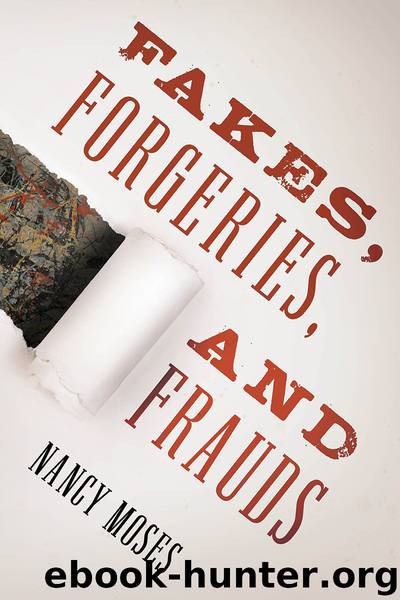Fakes, Forgeries, and Frauds by Nancy Moses

Author:Nancy Moses
Language: eng
Format: epub
Publisher: Rowman & Littlefield Publishers
Published: 2019-12-08T16:00:00+00:00
Figure 6.1. Old Nuremberg skyline, circa 1830.
Courtesy: Stadtarchiv Nuremberg, Germany
Figure 6.2. Old Nuremberg skyline today.
GettyImages Plus/Sean Pavone
But if Nuremberg’s medieval core had been demolished, what had led me to believe this reconstituted city was real? Did Nuremberg intentionally seek to create this impression, propagating a myth of a medieval city? How much of the old city had survived the war, and how much was postwar reconstruction? Frankfurt, Mainz, and other cities had built modern replicas to replace their ancient churches, public buildings, and homes. Was it the same in Nuremberg?
A few years ago, I returned to learn more and discovered that the real Nuremberg was much more complicated, a city shrouded in layers of myths created by successive generations. In the medieval period, it was the spiritual home of the Holy Roman Empire, known as the First Reich, or reign. In the nineteenth century, it was the poetical birthplace of German Romanticism. From 1923 to the outbreak of World War II, it was the mythical epicenter of the National Socialist Party that celebrated Adolf Hitler and the Third Reich. In 1945, when it hosted the Nuremberg Trials, the city became the aspirational focal point of a new world order. Most recently, it recast itself as the epicenter of human rights. Each of these dreams, each of these fantasies are embedded in the living city. Nuremberg is a city of rock and stone, wood, glass, and concrete. But as I came to realize, it is also a city of dreams, what historian Stephen Brockmann has called an “imaginary capital.”1 At critical moments, powerful people have imagined their own Nuremberg, projected their fantasies onto the material city, and shaped it to fit their dreams.
Nuremberg is not the only city of dreams; other places have also been fundamentally shaped to fit fantasies of how they ought to be. Take, for example, Colonial Williamsburg, which was a sleepy Virginia village before the great wealth of John D. Rockefeller Jr. transformed it into an American shrine. According to Robert Wilburn, former director of the Colonial Williamsburg Foundation, Rockefeller was motivated by a sentimental patriotism and nostalgia for what he thought was a better time. He envisioned Williamsburg as a celebration of America’s greatness and a place to learn the lessons of the past. To a significant extent, he made this vision come true.2
Since the 1930s, visitors to Colonial Williamsburg have been able to imagine themselves living in its most illustrious era: when it was the capital of colonial Virginia, the wealthiest and most influential of the thirteen colonies. The illusion is made even more powerful because the occupants—at least those seen by visitors—wear what appears to be authentic period clothing, work at authentic crafts, and cook more or less authentic seventeenth- and eighteenth-century food. Some of them parade through the town’s wide streets dressed as colonial soldiers. And the fantasy has continued to expand. When Rockefeller first arrived in the 1920s, there were eighty-eight original buildings in the town. Now there are 602 structures, few of which actually date from colonial times and most of which are meticulously researched replicas.
Download
This site does not store any files on its server. We only index and link to content provided by other sites. Please contact the content providers to delete copyright contents if any and email us, we'll remove relevant links or contents immediately.
| Espionage | Hoaxes & Deceptions |
| Murder & Mayhem | Organized Crime |
| Serial Killers | White Collar Crime |
Mindhunter: Inside the FBI's Elite Serial Crime Unit by John E. Douglas & Mark Olshaker(9186)
Wiseguy by Nicholas Pileggi(5668)
Room 212 by Kate Stewart(5034)
Hitman by Howie Carr(5017)
Secrecy World by Jake Bernstein(4639)
Killers of the Flower Moon: The Osage Murders and the Birth of the FBI by David Grann(4385)
Papillon (English) by Henri Charrière(4195)
Breaking Free by Rachel Jeffs(4174)
Killers of the Flower Moon by David Grann(3967)
Say Nothing by Patrick Radden Keefe(3903)
American Kingpin by Nick Bilton(3753)
The Secret Barrister by The Secret Barrister(3614)
Molly's Game: From Hollywood's Elite to Wall Street's Billionaire Boys Club, My High-Stakes Adventure in the World of Underground Poker by Molly Bloom(3484)
Mysteries by Colin Wilson(3393)
In Cold Blood by Truman Capote(3304)
Signature in the Cell: DNA and the Evidence for Intelligent Design by Stephen C. Meyer(3070)
I'll Be Gone in the Dark by Michelle McNamara(3015)
Rogue Trader by Leeson Nick(2975)
Bunk by Kevin Young(2948)
